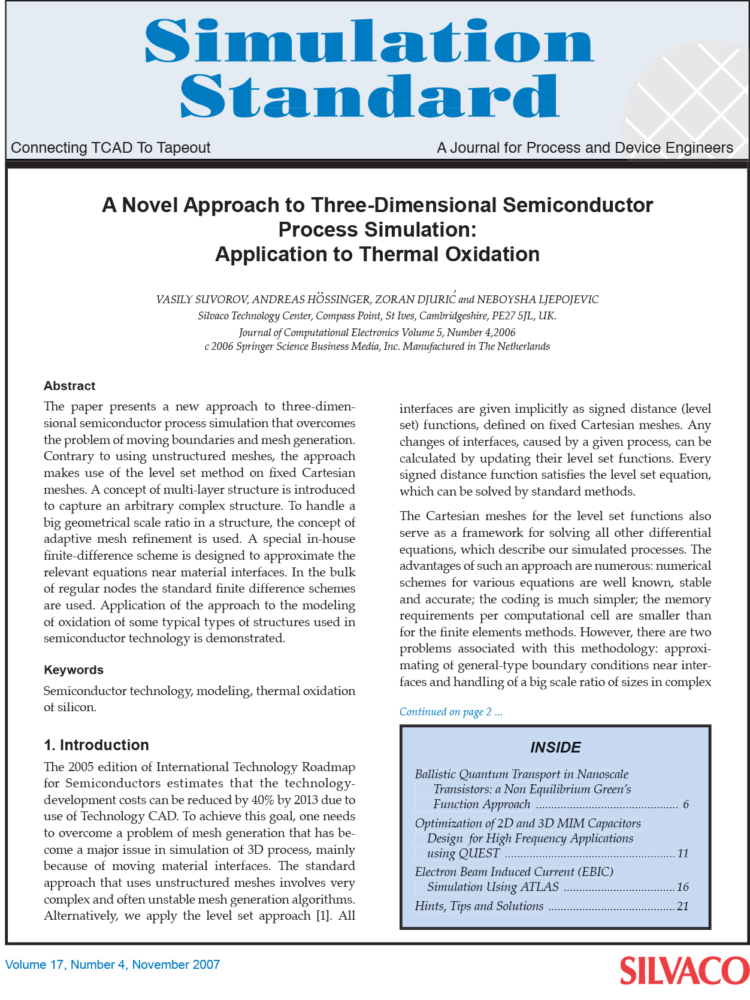A Novel Approach to Three-Dimensional Semiconductor Process Simulation: Application to Thermal Oxidation
VASILY SUVOROV, ANDREAS HÖSSINGER,
ZORAN DJURIC and NEBOYSHA LJEPOJEVIC
Silvaco Technology Center, Compass Point, St Ives, Cambridgeshire, PE27 5JL, UK.
Journal of Computational Electronics Volume 5, Number 4, 2006c
2006 Springer Science Business Media, Inc. Manufactured in The Netherlands
Abstract
The paper presents a new approach to three-dimensional semiconductor process simulation that overcomes the problem of moving boundaries and mesh generation. Contrary to using unstructured meshes, the approach makes use of the level set method on fixed Cartesian meshes. A concept of multi-layer structure is introduced to capture an arbitrary complex structure. To handle a big geometrical scale ratio in a structure, the concept of adaptive mesh refinement is used. A special in-house finite-difference scheme is designed to approximate the relevant equations near material interfaces. In the bulk of regular nodes the standard finite difference schemes are used. Application of the approach to the modeling of oxidation of some typical types of structures used in semiconductor technology is demonstrated.
Keywords
Semiconductor technology, modeling, thermal oxidation of silicon.
1. Introduction
The 2005 edition of International Technology Roadmap for Semiconductors estimates that the technology-development costs can be reduced by 40% by 2013 due to use of Technology CAD. To achieve this goal, one needs to overcome a problem of mesh generation that has become a major issue in simulation of 3D process, mainly because of moving material interfaces. The standard approach that uses unstructured meshes involves very complex and often unstable mesh generation algorithms. Alternatively, we apply the level set approach [1]. All interfaces are given implicitly as signed distance (level set) functions, defined on fixed Cartesian meshes. Any changes of interfaces, caused by a given process, can be calculated by updating their level set functions. Every signed distance function satisfies the level set equation, which can be solved by standard methods.
The Cartesian meshes for the level set functions also serve as a framework for solving all other differential equations, which describe our simulated processes. The advantages of such an approach are numerous: numerical schemes for various equations are well known, stable and accurate; the coding is much simpler; the memory requirements per computational cell are smaller than for the finite elements methods. However, there are two problems associated with this methodology: approximating of general-type boundary conditions near interfaces and handling of a big scale ratio of sizes in complex structures. In recent decades, considerable progress has been achieved in resolving both issues (e.g. [2], [3], [4] ). In our development we use our original in-house numerical method, the method described in [3] and the concept of Adaptive Mesh Refinement (AMR) [4]. The above principles are cornerstones of a software package Victory-Process, Silvaco’s three-dimensional process simulation framework. In this work we demonstrate Victory’s capability to simulate numerically the most demanding process, namely thermal oxidation.



